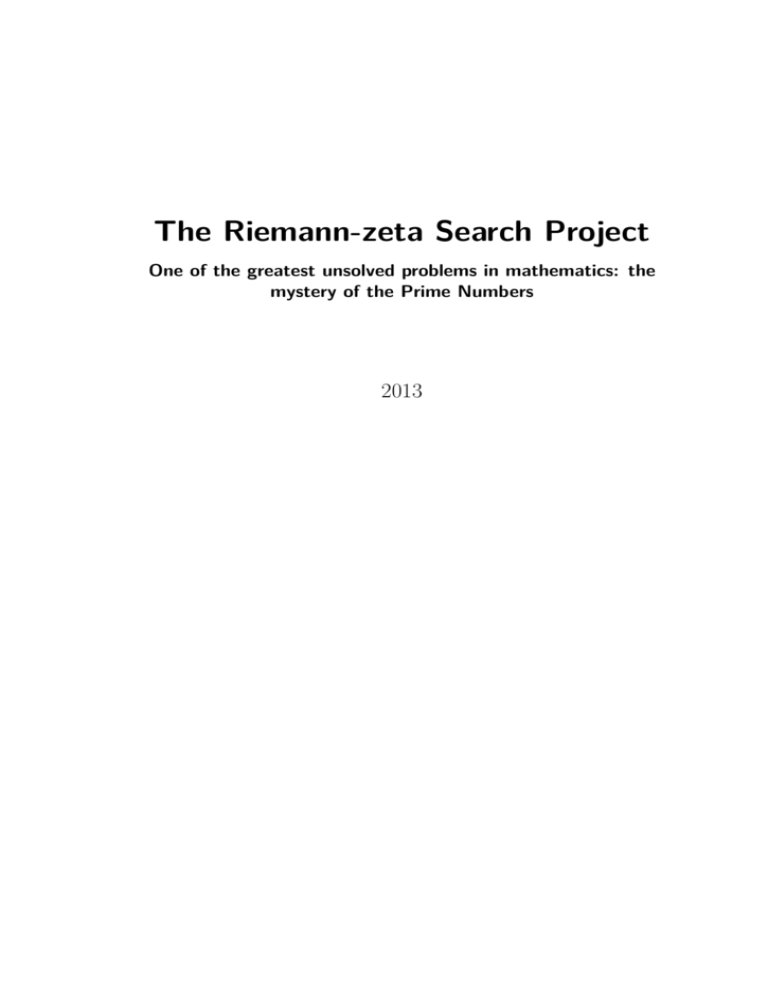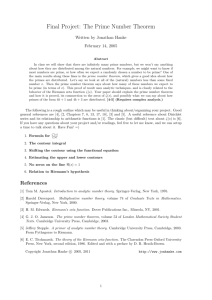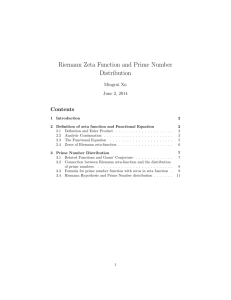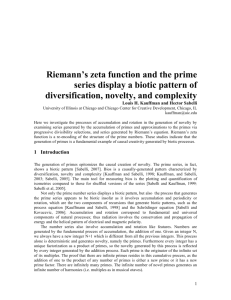ENG
advertisement

The Riemann-zeta Search Project
One of the greatest unsolved problems in mathematics: the
mystery of the Prime Numbers
2013
Significance of the problem
Prime numbers are the building blocks of mathematics and affects every part of
life. Primes can be found when you use your ATM card to buy something on e-bay,
or send e-mails. Prime numbers are natural numbers greater than one having only
two positive divisors, the one and itself. For example, 7 is prime, since the positive
divisors are only the one and the 7, while 6 is composite since in addition to 1 and
6 the numbers 2 and 3 are positive divisors as well. The Fundamental Theorem of
Arithmetic plays a central role in the field of number theory: any integer greater
than 1 can be expressed as a product of prime numbers, which are unique up to
order. The first few prime numbers are 2, 3, 5, 7, 11, 13, 17, 19, . . .. In 2013 the largest
known prime number is 257 885 161 − 1, consisting of more than 17 million digits. It is
well known that there are infinitely many primes, as proved by Euclid around 300
BC. In the 18th century Gauss conjectured that the number of primes up to x is
asymptotically x/ ln x. Many new results has been achieved in the past century with
respect to the prime numbers, but the distribution of primes remained unknown.
There are no known explicit formula for generating prime numbers. The Riemann
zeta function has an interesting property: the distribution of its zeros has the same
behaviour as the distribution of primes. The studies of the zeta function may lead us
to a deeper understanding of primes, may help us to unfold the mystery behind their
distribution. The main objective of this project is to generate lots of large values of
the zeta function, in order to reveal new patterns related to prime numbers.
Mathematical background of the searching method
In this section we would like to present the mathematical background of the searching
method. These methods are used by the searching algorithm.
Georg Friedrich Bernhard Riemann created the Riemann-zeta function in
the middle of the 19th century:
ζ(s) =
∞
X
1/ns , s ∈ C, s = σ + it .
n=1
This function, as a function of a real argument, was introduced and studied by
Leonhard Euler in the first half of the eighteenth century without using complex
analysis, which was not available at that time. Bernhard Riemannin 1859 extended
the definition of Euler to the complex plane and established a relation between its
zeros and the distribution of prime numbers. ζ(s) is convergent for R(s) > 1 and
divergent otherwise. Riemann extended the zeta function for Re(s) < 1 with analitic
continuation. ζ(s) have zeros for s = −2, −4, −6, . . ., which are called trivial zeros.
The function has other zeros as well, these are called non-trivial zeros. The first
2
non-trivial zero of ζ(s) is in s = 1/2 + 14.134725i. Riemann observed that all nontrivial zeroes of the ζ(s) lie on the so-called ’critical line’ σ = Re(s) = 1/2. This is
the famous Riemann-hypothesis, one of the most important unsolved problems in
mathematics.
The Riemann-Siegel formula or Z-function is a function used for studying the Riemann zeta-function along the critical line where the real part of the argument is
one-half. The Z-function can be defined in the following way:
Z(t) = 2
where N =
$
q
N
X
1
√ cos[θ(t) − t ln n] + O(t−1/4 ) ,
n
n=1
%
t/2π and θ(t) = 2t log 2πt − 2t −
π
8
+
1
48t
+
7
5760t3
+ ···
furthermore,
|Z(t)| =
ζ
!
1
+ it
2
It is not known any explicit formula for finding peak values of Z(t). The main goal
of this research is to locating many values where Z(t) is large in order to get a better
understanding of the behaviour of the distribution of primes. The searching method
based on the following.
Approximation of irrational numbers
Rational approximation, or alternatively, Diophantine approximation is very important in many fields of mathematics and computer science. Archimedes approximated
the irrational number π with 22/7. The work of John Wallis (1616–1703) and Christiaan Huygens (1629–1695) established the field of continued fractions. It is well-known
that continued fractions are one of the most effective tools of rational approximation
to a real number. Approximating different irrational numbers is called simultaneous
Diophantine approximation. Simultaneous Diophantine approximation originally
means that for given real numbers α1 , α2 , . . . , αn find p1 , p2 , . . . , pn , q ∈ Z such that
pi αi − q
is “small” for all i, and q is “not too large”.
In this research we are looking for integers where
k
log pi ·
< , (1 ≤ i ≤ n)
log 2 and k · k is the nearest integer distance function, that is, kαk = min{|α − j|, j ∈ Z}.
3
A new function
Locating large values of Z(t) let us define a new function:
ln t/2π
F (t) =
X
n=1
1
√ cos[θ(t) − t · ln n])
n
The most important observation is that F (t) has the same behavior as Z(t). We
can use F (t) to find good candidates where large Z(t) is highly probable.
Figure 0.1: Z(t) and F(t) have the same behaviour.
The main goal of this project
The aim of this project is to find very large values of Z(t). Analyzing these values
can be used to reveal new behaviour of the distribution of the prime numbers. All
values found by this project will be published in www.riemann-siegel.com
4











